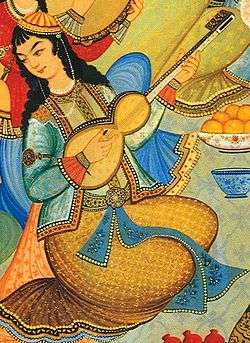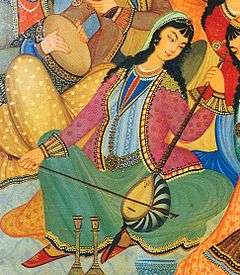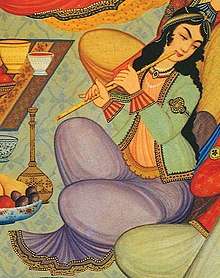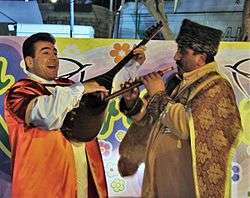Tar (string instrument)
 | |
| String instrument | |
|---|---|
| Classification | Plucked |
| Developed | Mirza Abdollah |
| Playing range | |
 (Shoor tuning) | |
| Related instruments | |
| Tanbur, Setar | |
| Musicians | |
| |
Tar (Persian: تار; Azerbaijani: tar) is an Iranian[1][2][3][4] long-necked, waisted instrument, shared by many cultures and countries including Iran, Azerbaijan, Armenia, Georgia, and others near the Caucasus region.[1][2][5] The word tār means "string" in Persian, and is also related to the names of the guitar, sitar, setar (سهتار, "three strings") and dutar (دوتار, "two strings").
It was invented in the 18th century[6][7] and has since become one of the most important musical instruments in Iran and the Caucasus, particularly in Persian classical music, and the favoured instrument for radifs.
In 2012, the craftsmanship and performance art of the Azerbaijani tar was added to the UNESCO's List of the Intangible Cultural Heritage of Humanity.[8]
Physical characteristics
The tar appeared in its present form in the middle of the eighteenth century in Persia. The body is a double-bowl shape carved from mulberry wood, with a thin membrane of stretched lamb-skin covering the top.
The fingerboard has twenty-five to twenty-eight adjustable gut frets, and there are three double courses of strings. Its range is about two and one-half octaves, and it is played with a small brass plectrum.
The long and narrow neck has a flat fingerboard running level to the membrane and ends in an elaborate pegbox with six wooden tuning pegs of different dimensions, adding to the decorative effect. It has three courses of double "singing" strings (each pair tuned in unison: the first two courses in plain steel, the third in wound copper), that are tuned in fourths (C, G, C) plus one "flying" bass string (wound in copper and tuned in G, an octave lower than the singing middle course) that runs outside the fingerboard and passes over an extension of the nut. Every String has its own tuning peg and are tuned independently. The Persian tar used to have five strings. The sixth string was added to the tar by Darvish Khan. This string is today's fifth string of the Iranian tar.
Music therapy

The melodies performed on tar were considered useful for headache, insomnia and melancholy, as well as for eliminating nervous and muscle spasms. Listening to this instrument was believed to induce a quiet and philosophical mood, compelling the listener to reflect upon life. Its solemn melodies were thought to cause a person to relax and fall asleep.
The author of Qabusnameh (11th century) recommends that when selecting musical tones (pardeh), to take into account the temperament of the listener (see Four temperaments). He suggested that lower pitched tones (bam) were effective for persons of sanguine and phlegmatic temperaments, while higher pitched tones (zeer) were helpful for those who were identified with a choleric temperament or melancholic temperament. [9]
Use in contemporary music
The tar features prominently in Jeff Wayne's Musical Version of The War of the Worlds, in the section "Horsell Common and the Heat Ray". George Fenton played it on the original album, and Gaetan Schurrer can be seen[10] playing one on the DVD of the 2006 production.
Azerbaijani tar
The "Azerbaijani tar" or "11 string tar" is an instrument in a slightly different shape from the Persian Tar and was developed from the Persian tar around 1870 by Sadigjan. It has a slightly different build and has more strings. The Caucasus tar has further one extra bass-string on the side, on a raised nut, and usually 2 double resonance strings via small metal nuts halfway the neck. All these strings are running next to the main strings over the bridge and are fixed to a string-holder and the edge of the body.[11] Overall the Caucasus tar has 11 strings and 17 tones.
A tar is depicted on the reverse of the Azerbaijani 1 qəpik coin minted since 2006[12] and on the obverse of the Azerbaijani 1 manat banknote issued since 2006.[13]
See also
References
- 1 2 tar (musical instrument). Encyclopædia Britannica . Retrieved on 2013-01-01.
- 1 2 "Iran Chamber Society: Music of Iran: Iranian Traditional Music Instruments". Iranchamber.com. Retrieved 2013-01-01.
- ↑ "Tar: About Tar, Role of Tar as an instrument". Sahbamotallebi.com. Retrieved 2013-01-01.
- ↑ OrientalInstruments.com. OrientalInstruments.com. Retrieved on 2013-01-01.
- ↑ "History of Iranian Music". Farhangsara.com. Retrieved 2013-01-01.
- ↑ "The Stringed Instrument Database". Archived from the original on 11 November 2013. Retrieved 2013-01-01.
- ↑ Oriental Instruments – Instrupedia – Tar
- ↑ Craftsmanship and performance art of the Tar, a long-necked string musical instrument. Unesco.org. Retrieved on 2018-04-29.
- ↑ Nettl, Bruno; Russell, Melinda (1998). In the Course of Performance: Studies in the World of Musical Improvisation. The University of Chicago Press. p. 30.
- ↑ Jeff Wayne's Musical Version of The War of The Worlds. Thewaroftheworlds.com (2007-08-16). Retrieved on 2013-01-01.
- ↑ Middle East. Atlas of Plucked Instruments. Retrieved on 2013-01-01.
- ↑ Central Bank of Azerbaijan. National currency: New generation coins. – Retrieved on 25 February 2010.
- ↑ Central Bank of Azerbaijan. National currency: 1 manat. – Retrieved on 25 February 2010.
External links
| Wikimedia Commons has media related to Tar (lute). |



